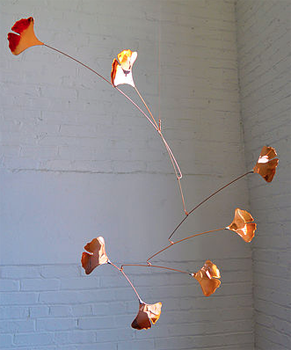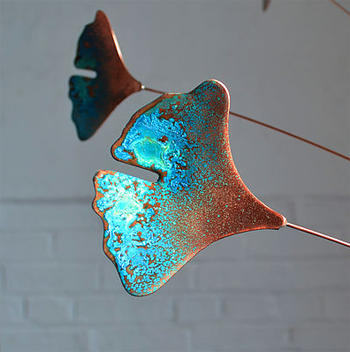JFJones Mobiles: Nature-Inspired Copper Mobiles
 JFJones copper ginko mobile.
JFJones copper ginko mobile.Photograph courtesy of Jay Jones.
About 11 years ago, Jay Jones made a visit to the National Gallery of Art in Washington, D.C. that changed the course of his professional career in the arts.
“There is one of the largest pieces of Alexander Calder’s in the rotunda,” he recalls. “I was pretty mesmerized by it.”
What captivated Jones was a combination of the scale of the piece, along with its ability to be balanced.
“It is made of steel but it was floating,” he says. “It had an illusion of weight and weightlessness all at the same time.”
Jones also took note that if a mobile is balanced correctly, the slightest change in the air movement will make it move.
“What a mobile will do is make you slow down and make you stop and watch it because it is slightly moving,” he says.
Before making the mobiles, Jones was a furniture builder and graphic designer in New York City. For a period of time he built sets for theater, TV and commercials.
“I designed a line of furniture and moved out of New York for the manufacturing,” Jones says.
In 2007, after making mobiles for about a year that were largely influenced by Calder’s work, a client’s request led him to copper.
“Once I used copper, I found it was the perfect material for what I was doing,” he says. “It was easy, it was malleable and I could easily form it.”
Jones also liked that copper was readily available, among other things.
“The connectivity between the shape and the rods are so easy because you can just solder them together. Before, it was laborious,” he says, referring to challenges posed to him when using wood, aluminum and plastics prior to copper.
 Close up of JFJones's Ginkgo mobile with copper patina.
Close up of JFJones's Ginkgo mobile with copper patina. Photograph courtesy of Jay Jones.
Jones found the more copper mobiles he made, the more requests he received for them. A majority of his kinetic sculptures are nature-oriented in subject matter. Influenced by the nature around him, Jones began to focus on ginkgo leaves.
“In Greensboro, where I live, their main street there is called Elm Street,” he says. “Somewhere along the line someone planted two dozen ginkgo trees. One day, when I was working downtown, it was in the fall and this green leaf turns this vibrant, yellow-gold color. The entire street was covered with leaves which inspired his ginkgo leaf series.
Today, Jones averages the making of about 2,700 mobiles per year.
“I think we are in over 250 high-end art/gallery shops,” he says. They sell a majority of their work through Uncommon Goods. All of the mobiles in his JFJones Mobiles line are handcrafted.
“Because we are doing such volume of these pieces, I had to make dies for the copper leaves,” he says, adding he used to cut all of the shapes out by hand. “There is a lot of polishing and hand-forming after they are cut out.”
After soldering the rods on the leaves, there is another series of polishing that goes into that portion of the process.
“About 75% of the time is prepping the materials before you make a mobile out of it,” Jones says.
In addition to his mobiles, Jones is beginning to develop some small, desktop sculptures that also incorporate copper.
 Copper mobile artist, Jay Jones.
Copper mobile artist, Jay Jones.Photograph courtesy of Jay Jones.
Whether Jones is working on a mobile or desktop sculpture, he uses oxidizing material to give each piece his signature look.
“You put the copper in a bath of this sulphur solution,” he says. “It turns the copper completely black and then I polish that out and it looks like pewter.”
Jones purchases his copper through the roofing industry in Greensboro, NC.
“I buy 3 x 8 foot sheets of 6 gauge, 2 oz. copper, so it’s a nice, heavy-duty copper,” Jones says.
He works out of a space that is divided into a studio and a shop.
“The prototyping and samples are done in the studio and the shop is where we are producing stuff,” Jones says.
His wife, Naomi, works with him in various capacities.
“I do most of the sales at trade shows and I usually pick the trade shows we do,” Naomi says. Their next show will be AmericasMart in Atlanta in July.
Naomi also works on the distribution for other things in Jones’ line, such as an educational kit he produces for children.
“I created a product that is a mobile called Modern Mobiles,” he says. “It’s a kit that kids can put together themselves. It’s real, hands-on learning about kinetic sculptures. We sell them at the Museum of Modern Art, the Guggenheim, the National Gallery, The Smithsonian – we are in well over 100 museum shops around the country.”
On occasion, Naomi also works with him in the prototyping process.
“We have been getting more and more requests for wall pieces,” Jones says.
Naomi said she is interested in expanding their business right now, by providing their copper pieces to more healthcare providers and retirement centers.
“I’m really excited to find out about the fact that copper is chosen to be used in hospitals because it doesn’t transmit bacteria,” she says.
Another area she is eyeing up the potential for expansion is hotels.
“We have been talking to some interior designers about projects and I’d really like to see one of those happen,” Naomi says, adding their ginkgo and butterfly mobiles would be well-suited for hotel rooms and meeting rooms.
“They are beautiful to decorate with,” she says of the mobiles. “We have this natural design from nature and then to bring them inside – it’s like bringing the outdoors indoors. Copper is such a warm material. It’s almost like a skin tone and people love it and it makes me think of home.
Resources:
Also in this Issue:
- Watermark Designs: Luxury Brass Fixtures Handcrafted in Brooklyn
- Form Meets Function: Caldwell Mountain Copper
- Prancing Pony Glass: Copper Foil Takes Shape
- JFJones Mobiles: Nature-Inspired Copper Mobiles
- Georgia Museum of Art Debuts Mixographia
